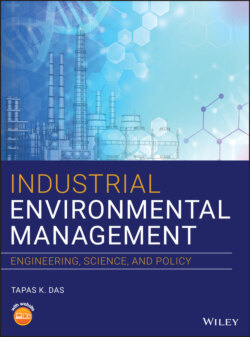Читать книгу Industrial Environmental Management - Tapas K. Das - Страница 169
2.17 Greenhouse Gases
ОглавлениеUSEPA decided to regulate greenhouse gases as air pollutants under the CAA. Three major development have occurred (USEPA 2011). First, in the Supreme Court case of Massachusetts v. EPA, the court ruled in a 5‐to‐4 decision that the EPA has the statutory authority to regulate CO2 and other greenhouse gases as air pollutants under the CAA (Cornell University 2007). Second, on 22 September 2009, the EPA administrator signed the Final Mandatory Reporting of Greenhouse Gases Rule. Under this rule large emission sources and suppliers are required to report greenhouse gas emissions (2009a; 2009b). The intention of the rule is to collect accurate data for future policy decision making on climate change mitigation. Third, in December 2009 the EPA made a finding that greenhouse gases endanger human health and welfare, in response to the (CO2), methane (CH4), nitrous oxide (N2O), hydrofluorocarbons (HFCs), perfluorocarbons (PFCs), and sulfur hexafluoride (SF6). This endangerment finding is a requisite to the EPA developing emission standards for greenhouse gases.
Figure 2.6 Cumulative growth in federal environmental laws and amendments in the United States.
Source: Adopted from Allen and Shonnard (2002) and Sullivan and Adams (1997).
There are approximately 20 major US federal statues, hundreds of states and local ordinances, thousands of federal and state regulations and even more federal and state court cases and administrative adjustments, etc. that deal with environmental issues. Taken together, they make up the field of environmental law, which has seen remarkable growth in the last 30 some years, as shown in Figure 2.6 (Allen and Shonnard 2002).
All engineers, particularly in the branches of chemical, civil, environmental, mechanical, metallurgy, mining, and nuclear should be familiar with environmental laws and regulations because they affect the operations of many processes and professional responsibilities involved in their respective fields. Environmental regulations and the common law system of environmental law require actions by affected entities. For examples, the CAA (an environmental statute) requires facilities which emit pollutants from a stack (point source) into an air‐shed to apply for a Prevention of Significant Deterioration (PSD) permit; and the CWA requires facilities that discharge pollutants from a pipe or an outfall (point source) into navigable waters to apply for a National Pollutant Discharge Elimination System permit. In many companies, engineers are responsible for applying and obtaining these permits. The common law created by judicial decision also encourages engineers to act responsibly when permitting their professional duties because environmental laws and regulations do not cover every conceivable environmental wrong. Engineers need to be aware of potential legal liability resulting from violation of environmental laws and regulations to protect their companies and themselves from legal and administrative actions.
